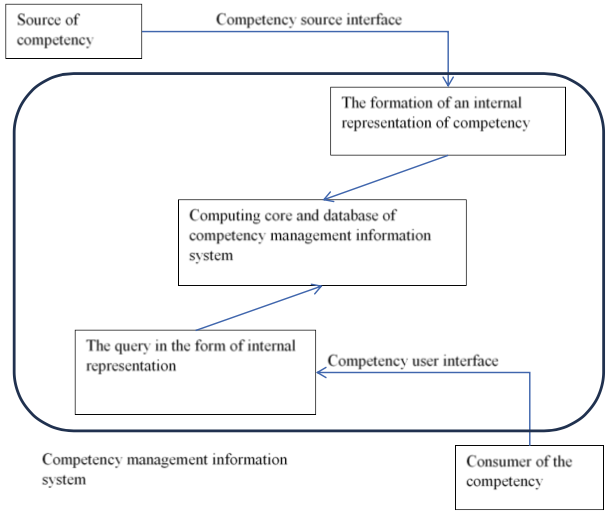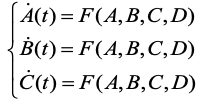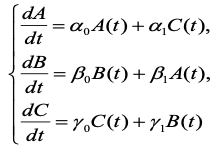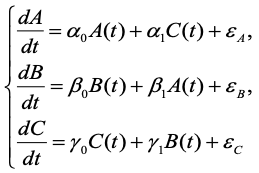

Vol. 40 (Issue 42) Year 2019. Page 12
ERMAKOV, Vladimir A. 1; KASHIRIN, Alexander I. 2; MURTUZALIEVA, Svetlana Yu. 3 & DIESPEROVA, Natalya A. 4
Received: 25/07/2019 • Approved: 28/11/2019 • Published 09/12/2019
ABSTRACT: The article deals with the problem of creating innovative competency management tool concerning high-tech industries. The application of such tool and mechanisms provides an opportunity to ensure the active implementation of intellectual property in the economic and commercial turnover, as well as to form a proactive response in the operational and strategic management of the intellectual property of the organization to the market challenges faced by the enterprise. Creating the innovative competency management tool aims at maintaining the competitiveness of the organization, its products and services, as well as providing conditions for effective development, use, implementation, and attraction of organization’s innovative competencies. The practical outcome of the article consists of a developed innovative competency management tool provided with a description of the step-by-step technique, the elements of which can be automated in the form of a software package. |
RESUMEN: El artículo aborda el problema de crear una herramienta innovadora de gestión de competencias con respecto a las industrias de alta tecnología. La aplicación de dicha herramienta y mecanismos brinda la oportunidad de garantizar la implementación activa de la propiedad intelectual en la rotación económica y comercial, así como de formar una respuesta proactiva en la gestión operativa y estratégica de la propiedad intelectual de la organización a los desafíos del mercado enfrentados por la empresa. La creación de la herramienta innovadora de gestión de competencias tiene como objetivo mantener la competitividad de la organización, sus productos s y sus servicios, así como brindar las condiciones para el desarrollo, uso, implementación y atracción efectiva de las competencias innovadoras de la organización. El resultado práctico del artículo consiste en una herramienta de gestión de competencias innovadora desarrollada que incluye una descripción de la técnica paso a paso, cuyos elementos se pueden automatizar en forma de un paquete de software. |
The innovative competencies management is the process of forming competencies, their development (improvement) and use (application) for the design, production, and promotion of globally competitive products and services (Chursin, Makarov, 2015; Chursin et al., 2017; Ansoff, 2009; Sokół, Figurska, 2017; Girdzijauskaite et al., 2019).
The main purpose of managing the process of formation, development, and use of innovative competencies within the company is to organize the exchange of technologies, innovations, and other intellectual property. The exchange of competencies represents the implementation of mediation activities that ensure interaction between the owners and consumers of competencies in order to acquire the required competencies by consumers (Bocharov, 2012; Oganisjana et al. 2017; 2018).
A distinctive feature of this mechanism is that the subjects of the transaction are competencies, rather than products and knowledge in and of themselves, that is, the knowledge and ability of their owners to solve the problems of consumers in creating and producing competitive products and technologies.
The application of such mechanisms provides an opportunity to ensure the active introduction of intellectual property in the economic and commercial turnover, as well as to form a proactive response in the operational and strategic management of organization’s intellectual property.
Our purpose of creating the innovative competency management tool is maintaining the competitiveness of the organization,its products and its services, as well as providing conditions for effective development, use, implementation, and attraction of organization’s innovative competencies.
The objectives of the innovative competency management tool include:
The functions of innovation competencies management technique include the following items:
The innovative competency management tool will contribute to the creation of systems providing:
Competencies management tools are the means of preparation and implementation of managerial decisions. The tools are used for managerial impact when planning and controlling the use of quality characteristics and their numerical values established by the task with regard to the competency management object at a given time.
Research and practice of the competency-based approach have shown that the unique technological competencies, as the highest level of technological competency (UTC), are created (formed) by teams of specialists when solving nonstandard, new scientific and technical problems and tasks aimed at developing new technologies and products. In the course of these processes, skills and approaches are developed not only to solve a specific, already implemented topic, but also a potential opportunity for this team of specialists to solve many new problems and tasks based on repeated use of their UTC in order to create new products and technologies in various fields of application.
Thus, the existing problems and long-term tasks that are solved either by internal resources of the organization, primarily by scientific and technical specialists with appropriate technological competency within the framework of internal R&D, or external competencies, serve the basis for the creation of new UTC. In turn, it is the global challenges that are the fundamental basis to form new global tasks. The interaction pattern of internal and external UTC, problems and tasks is presented in Fig. 1:
Figure 1
The interaction pattern of internal and external UTC, TRIZ (Theory of Inventive Problem
Solving (Russian abbreviation TRIZ is internationally used)), problems, and tasks.

The presented interaction pattern shows that UTC is created within both the organization based on the solution of existing problems and objectives by the organization’s staff, who possess the technological competencies and have the potential to solve these problems and challenges and external UTC, which are outside the organization. At that, the UTC is created through the implementation of R&D as well as design and development work.
The interaction pattern reflecting the progression of competency from its source to the final user is presented in Fig. 2
Figure 2
Competency management information system.

The overall objective of such a system is to formalize and classify all competencies existing in the organization with the possibility of their dissemination.
Decomposition of the generalized process of competency management allows talking about the following basic processes in the mechanism:
The described approach considers the competency management information system as a special structural unit of the organization’s corporate infrastructure, ensuring the collection, storage, and provision of relevant knowledge in order to obtain maximum benefit from them, as well as attracting the necessary missing knowledge to the organization.
Performance evaluation of innovative competency management tools should be based on a comparison of the results of the implementation of mechanisms with the goals and objectives that have been defined for these mechanisms. Given that the development and implementation of mechanisms for managing innovative competencies have several goals and objectives, it is advisable to consider the effectiveness of tools in each direction of the expected effect.
The development and implementation of innovative competency management mechanisms can lead to a reduction in direct costs for the development, refinement, and promotion of products, and, in particular, a reduction in R&D costs, as well as a reduction in the lead time of new products and technologies. The use of mechanisms such as crowdsourcing can improve the accuracy of demand forecasting for products and services, as well as financial forecasting. Improving the accuracy of products development and production planning can contribute to improving the accuracy of cash flow forecasting that can improve the economic, financial, and logistical performance of the organization.
The development and implementation of innovative competency management mechanisms can lead to an expansion in the range of products and services provided, as well as to an increase in their demand from the consumer, which can result in an increase in sales and market share of organization’s products and services, and thus increase revenue and profit.
Use of innovative competency management mechanisms can lead to improvement of internal processes of the organization that will allow optimizing the use of resources of the organization and reduces the time required to search for the solution to the organization’s problem. Also, the use of innovative competency management mechanisms can result in a systematic reduction of various organization risks (commercial, strategic, business, logistics, overproduction, etc.).
Ultimately, summarizing up the effects in all the above areas, the implementation of innovative competency management mechanisms has positive impact on the following integrated indicators of the organization:
Currently, the following classification of competencies by their scope of application is supported in the world practice:
The only consistent method for implementing the aforementioned tasks is the development of a software package that implements the approaches described in the article. The stages of formation of technical requirements for software (before integration into existing systems for managing enterprises and holdings) may look as follows:
Stage 1. Definition of criteria and performance indicators of the software package for managing innovative competencies.
Stage 2. Modeling of objects and subjects of management of innovative competencies, as well as relationships between them.
Stage 3. Modeling of characteristics and functionality of innovative competency management tools.
Stage 4. Modeling of resources required to use innovative competency management mechanisms.
Stage 5. Implementation of information and analytical methods for collecting and storing, as well as changing and supplementing information on innovative competencies of an organization.
Stage 6. Implementation of information and analytical methods for the exchange of information on innovative competencies of an organization with sources of competencies, as well as end-users of competencies.
Stage 7. Software implementation of scenarios of the mechanism for managing innovative competencies.
Stage 8. Automated generation of reports on the work of mechanisms for managing innovative competencies for top managers of an organization, considering previously defined forms of storage and work with information on innovative competencies of an organization.
Generation stages of innovative competency management mechanisms and expected results from their application
Practical management of innovative competencies is related to the issues concerning their identification and storage, involvement and dissemination, as well as their development. Creating a mechanism for managing innovative competencies is a step-by-step multistage process, the ultimate goal of which is the practical implementation of the necessary functionality for the innovative competencies management in the form of information and analytical system.
Generation of innovative competency management mechanisms consists of the stages considered below.
At this stage, it is necessary to determine the feasibility of developing and implementing the innovative competency management mechanisms, as well as identify goals and objectives, which will be achieved through the use of these mechanisms. It is also necessary to determine the scope of the organization's activities and specific indicators that will be affected by the use of the developed innovative competency management mechanisms. These may be indicators of different levels and content, such as operation indicators of units and groups within the organization, indicators reflecting the generation of intellectual property, characteristics, and functionality of products, the overall economic performance of the organization, etc.
Activities being undertaken at this stage are the following:
Stage outcomes are as follows:
At this stage, it is necessary to formalize the management objects, namely, innovative competencies, as well as other participants of the competency management mechanism, such as the consumer of competencies, the source of competencies, and the operator of the management mechanism. That is, the task arises concerning the formal description and generalization of information about the existing competencies of enterprises of knowledge-intensive industries. To do this, it is necessary to define the basic criteria describing innovative competencies within the framework of the competency management mechanism.
Objectives of the stage are as follows:
Stage outcomes are as follows:
Organization of interaction between competency sources and consumers requires some of specially developed tools that allow forming the image of competencies, conducting their information analysis of various nature, and providing communication between competency management objects and subjects. Such tools may include the competency describing the procedure, assessment of competency, ranking and identification of key competencies, search among competencies, and many other things. This requires the definition and description of information links, objects, and subjects of management in the competency management mechanism.
Objectives of the stage are as follows:
Stage outcomes are as follows:
At this stage, it is necessary to determine resources inside and outside the organization, which are required to ensure the functioning of the competency management mechanism. It is necessary to classify them, as well as to determine their cost and risks associated with their use. It is also necessary to consider possible alternatives to the resources used.
Objectives of the stage are:
Stage outcomes are as follows:
Objectives of the stage are:
At this stage, it is necessary to select the methods of collecting, storing, and processing information about the organization’s innovative competencies.
The requirements formalization process with respect to the practical implementation of the formed innovative competency management mechanism is necessary for:
Requirements for the practical implementation of the generated innovative competency management mechanism include the following:
At this stage, it is necessary to determine the interaction order and form of the innovative competency management mechanism with the source and the consumer of innovative competencies.
Objectives of the stage are:
Stage outcomes are:
At this stage, it is necessary to carry out modeling and describe possible scenarios of the innovative competency management mechanism.
Objectives of the stage are:
Stage outcomes are:
Below is described the management process of unique competencies using a mathematical model.
The following types of innovative competencies are considered with appropriate economic indicators:
Next, a dynamic system is described that allows simulating different scenarios of competency management.
Since further a dynamic model will be considered, it is necessary to introduce the time in this model. Usually, in economic models, discrete time is considered, because many processes develop over a long time, however, for qualitative results, it is convenient to consider continuous time since in this case obtained mathematical models are more compact. Note that, if necessary, it is always possible to obtain a discrete model based on a mathematical model with continuous time. Thus, the processes with continuous time (t) will be considered.
Consider the case of a finite time interval, which is quite sufficient for the proposed model.
The values A(t), B(t), C(t), D(t) describe a dynamic model of innovative competencies management.
The system of differential equations describing the dynamic system has the form:

When constructing the formal bases for economic and mathematical models, it is necessary to choose the main numerical characteristics to describe the corresponding economic quantities. We will consider dimensionless quantities, which qualitatively describe the state of economic quantities. Therefore, numerical values of functions represent values of integral indicators to describe the level of the considered competencies.
The specific values of these indicators of innovative competencies may not have a specific economic meaning since the economic importance consists in comparing these values. For example, one can say that the level of competency at a time t1 is higher (lower) than that at a time t2.
The dynamics of the values under consideration, which describe innovative competencies, can be described by the following system of linear differential equations:

In these equations, each dynamic variable has a certain coefficient ![]() that reflects the objective reduction of all indicators over time in view of the overall development of the economy and scientific and technological progress, if there is no management of innovative competencies.
that reflects the objective reduction of all indicators over time in view of the overall development of the economy and scientific and technological progress, if there is no management of innovative competencies.
In the described model, the coefficient of technological competencies increases under the influence of the coefficient of research competencies; the coefficient of production competencies increases under the influence of technological competencies, while the coefficient of research competencies increases under the influence of production competencies. Management of innovative competencies in the framework of this scenario allows developing simultaneously the entire set of competencies, and at the same time increasing the proper indicators describing them.
External influence describing the innovative competencies management, as well as the impact of random factors can be described using heterogeneous coefficients ![]() . These coefficients describe the qualitative nature of changes in the innovative competencies indicators that occur in consequence of the implementation of measures to manage innovative competencies. The system of differential equations taking into account the control actions can be written as follows:
. These coefficients describe the qualitative nature of changes in the innovative competencies indicators that occur in consequence of the implementation of measures to manage innovative competencies. The system of differential equations taking into account the control actions can be written as follows:

The system of differential equations describing the dynamics of innovative competencies indicators can be solved by one of the standard methods, for example, the Runge-Kutta method of the 4th order. Since this model describes the dynamics of innovative competencies in time, the initial values of the competency indicators can be taken equal to unity:
![]()
Thus, in the presence of initial values of the innovative competencies dynamics model, the simulation modeling of the innovative competencies management process can be carried out.
As a result of modeling, optimal scenarios of innovative competencies management can be selected based on the criteria described in the next stage.
At this stage, the performance efficiency of innovative competency management mechanisms is assessed based on the following system of standard economic indicators of the organization:
For strategic planning, the organization can build predictive trajectories of changes in these indicators. With a significant deviation of the actual values of indicators from the forecast, one can talk about the inefficient management of technological competencies and the need for strategic decision-making.
At this stage, it is necessary to develop forms and regulations for reporting on the operation of both the innovative competency management mechanism in general and specifically the constituent tools. Such reports will have to be generated in a special form approved by the management of the organization based on up-to-date database information. These reports can be presented in both electronic form, as a sample retrieved from the information database, and in the printed version.
Objectives of the stage are as follows:
Stage outcomes are as follows:
The present work offers the innovative competencies management algorithm representing actions and tools to form competencies, their development (improvement) and use (application) for design, production, and market promotion of globally competitive products and services.
All mathematical calculations and algorithm techniques can be effectively implemented in the form of computer programs.
This paper was financially supported by the Ministry of Education and Science of the Russian Federation on project No. 26.1146.2017/4.6 «Development of mathematical methods to forecast efficiency of using spatial services in the national economy».
Ansoff, I. (2009). Strategicheskij menedzhment [Strategic management]. St.Petersburg, Peter, 334.
Bocharov, A. (2012). Mekhanizm upravleniya innovaciyami v usloviyah nestabil'nogo sprosa [Innovation management mechanism in the context of unstable demand]. Moscow, Lambert Academic Publishing, 180.
Brodetsky, G.L. (2010). Sistemnyj analiz v logistike, vybor v usloviyah neopredelyonnosti [System analysis in logistics, choice under uncertainty]. Moscow, Academy, 336.
Burkov, V.N., Kvon, O.F., and Tsitovich, L.A. (1998). Modeli i metody mul'tiproektnogo upravleniya [Models and methods for multiproject management]. Moscow, Trapeznikov Institute of Control Sciences, Russian Academy of Sciences, 62.
Burkov, V.N., Novikov, D.A., and Shchepkin, A.V. (2008). Mekhanizmy upravleniya ekologo-ekonomicheskimi sistemami [Mechanisms of ecological and economic systems management]. Moscow, Fizmatlit, 244.
Chursin, A., and Makarov, Y. (2015). Management of competitiveness: Theory and practice. Springer International Publishing, 378. doi: 10.1007/978-3-319-16244-7
Chursin, A.A., Shamin, R.V., and Fedorova, L.A. (2017). The mathematical model of the law on the correlation of unique competencies with the emergence of new consumer markets. European Research Studies Journal, 20(3), 39-56.
Girdzijauskaite, E., Radzeviciene, A., Jakubavicius, A. (2019). Impact of international branch campus KPIs on the university competitiveness: FARE method. Insights into Regional Development, 1(2), 171-180. doi: 10.9770/ird.2019.1.2(7)
Sokół, A., Figurska, I. (2017). Creativity as one of the core competencies of studying knowledge workers. Entrepreneurship and Sustainability Issues, 5(1), 23-35. doi: 10.9770/jesi.2017.5.1(2)
Oganisjana, K., Surikova, S., Kozlovskis, K., & Svirina, A. (2018). Financial, organisational and informative involvement of the society in social innovation processes in Latvia. Entrepreneurship and Sustainability Issues, 6(1), 456-471. doi: 10.9770/jesi.2018.6.1(28)
Oganisjana, K., Svirina, A., Surikova, S., Grīnberga-Zālīte, G., Kozlovskis. K. (2017). Engaging universities in social innovation research for understanding sustainability issues, Entrepreneurship and Sustainability Issues 5(1): 9-22. doi: 10.9770/jesi.2017.5.1(1)
1. Peoples' Friendship University of Russia (RUDN University), Russia
2. Peoples' Friendship University of Russia (RUDN University), Russia
3. Peoples' Friendship University of Russia (RUDN University), Russia
4. Peoples' Friendship University of Russia (RUDN University), Russia
Email contact: sciencedept@mail.ru